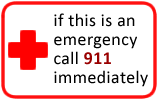STD - Prevention
STD - Prevention
Does this describe your symptoms? |
Definition
General Information
Transmission
Abstinence and Other "Safe" Sexual Activities
Behaviors That Do Not Prevent STD's
Additional Resources
|
If not, see these topics
|
When to Call Your Doctor |
Call Your Doctor Now (night or day) If |
|
|
|
Call Your Doctor Within 24 Hours (between 9 am and 4 pm) If |
|
|
|
Call Your Doctor During Weekday Office Hours If |
|
|
|
Self Care at Home If |
|
|
HOME CARE ADVICE FOR PREVENTING STD'S |
General condom information:
Latex condoms are the only effective way to prevent STDs during sexual intercourse.
You can also use condoms during oral sex.
Obtaining a condom:
Buy latex rubber condoms. Persons who are allergic to latex can use a polyurethane (plastic) condom. Never use condoms made from animal skins; they can leak.
You can get condoms at public health clinics (often free), drug stores, supermarkets, and via the internet. You do not need a prescription.
Storing condoms
Store condoms at room temperature. Avoid extreme heat, extreme cold, or sunlight.
You might want to keep a condom in your wallet or purse; this way it is ready and available.
Putting on a condom - Instructions:
Hold the condom at the tip to squeeze out the air.
Roll the condom all the way down the erect penis (Do not try to put a condom on a soft penis).
If you use a lubricant during sex, make sure it is water-based (e.g., K-Y Liquid, Astroglide). Do not use petroleum jelly (Vaseline), vegetable oil (Crisco), or baby oil; these can cause a condom to break.
Taking off a condom - Instructions:
After sex, hold onto the condom while the penis is being pulled out.
The penis should be pulled out while still erect, so that sperm (semen) doesn't leak out of the condom.
Female condoms
There are female condoms (e.g., Reality) that you can also buy without a prescription.
A female condom is a polyurethane (plastic) sheath that is placed inside the vagina.
STD National Hotline
The CDC National STD Hotline provides information on sexually transmitted diseases (STDs), such as chlamydia, gonorrhea, HPV/genital warts, herpes, and HIV/AIDS. Specialists can provide general information, referrals to local clinics, and written materials about STDs and disease prevention.
Toll-free number (English): (800) 227-8922
Toll-free number (Spanish): (800) 344-7432
Their website is at: http://www.ashastd.org
Pregnancy test, when in doubt:
If there is any possibility of pregnancy, obtain and use a urine pregnancy test from the local drug store.
Follow the instructions included in the package.
Call Your Doctor If:
Pregnancy test is positive or if you have difficulties with the home pregnancy test
You become worse
And remember, contact your doctor if you develop any of the "Call Your Doctor" symptoms.
Updated:
March 22, 2017



